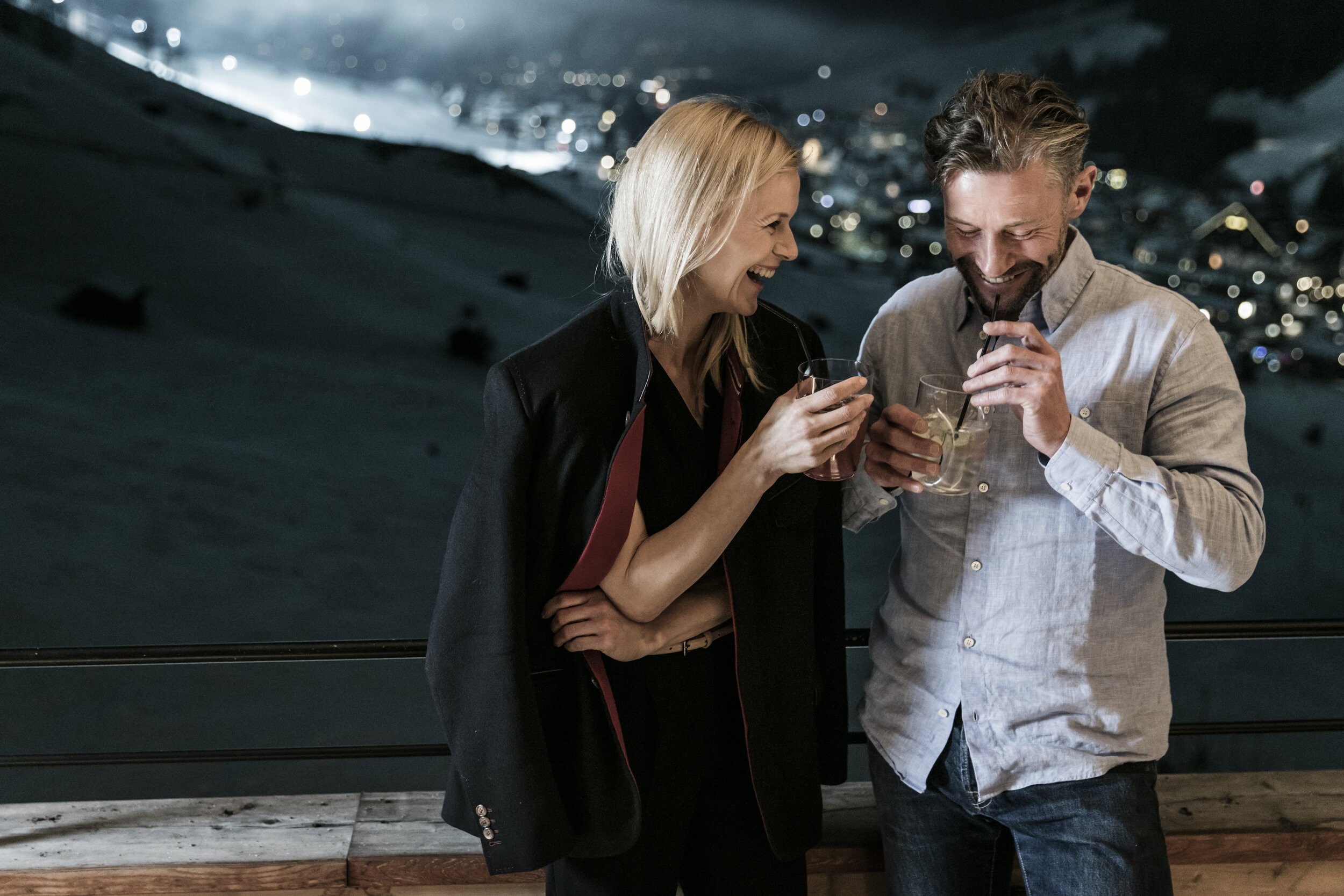THE PERFECT PITSTOP
OOBEN, ST ANTON
A boutique hotel and gourmet restaurant attached to the most raucous après-ski bar in the Alps might sound like a recipe for disaster but Gabriella Le Breton discovers it works a treat at MOOSER, St Anton
For Members familiar with St Anton, the word Mooser is likely to summon up fond memories of the infamous piste-side après-ski bar, the MooserWirt. The self-proclaimed “baddest” bar in the world, the MooserWirt is the essence of Austrian oompah après action, with table-top dancing fuelled by vast quantities of beer, Jägermeister and music provided by the octogenarian DJ Gerhard.
I doubt whether the great, great grandfather of the MooserWirt’s hospitable owner, Eugen Scalet, would recognise the simple timber chalet he built on pastures above St Anton in the 1880s, which now houses the famously pumping bar. A century after those foundations were laid, and struggling to make the family tradition of Alpine dairy farming pay, Scalet sold his herd in 1989 and started serving dinner to friends and skiers-by in his cowshed. Three years later, the MooserWirt hit its stride, abandoning dinners for more liquid entertainment accompanied by live music.
In 2000, Scalet extended the MooserWirt and installed a subterranean labyrinth of mechanised beer, glühwein and spirit ‘parlours’ (replacing the former milking parlours). Linked up to the indoor and outdoor bars by 20 miles of cable, Scalet’s army of bar staff could now serve up to 5,000 litres of beer a day with their ‘pistol’ drinks dispensers.
Eleven years later, the irrepressible Scalet launched the MOOSER hotel. Hewn out of the mountain, below the MooserWirt, the luxurious property comprises 17 bedrooms, a two-storey spa and the OOBEN restaurant and bar. The last is located on the top floor, in the eaves of what was originally the cowshed and then the Scalets’ bedroom (‘oben’ in German means above). The carved wooden eaves and beams frame double-height windows and uninterrupted views over St Anton while plump leather chairs, minimalist décor and a state-of-the-art open kitchen create a sleek, contemporary urban vibe.
Book for dinner and you’ll enjoy an intimate vibe with views of moon-illuminated mountains and the glittering lights of St Anton below you. Book for lunch and you’ll enjoy the sweeping views in daylight but you won’t get to sample OOBEN’s refined cuisine, as the restaurant serves the MooserWirt menu at lunch (think juicy steaks, towering burgers, jacket potatoes, hearty soups and stews). Whichever you go for, allow time for apéritifs at the bar before your meal!
Led by the young Tyrolean chef Lukas ‘Luggi’ Gritsch, OOBEN’s chefs beaver away, whipping up sophisticated cuisine quite literally before your eyes to match their surroundings. The dishes are as pretty as pieces of art yet pack serious taste punch and, despite being the product of thoroughly contemporary cuisine expertise, they’re rich in Tyrolean heritage and prepared using almost exclusively local produce.
Delicately flavoured beef tartare is topped with saffron yellow egg yolk espuma, dainty pearl onions and local Belper Knolle cheese (€22); a dainty but flavoursome venison osso bucco, served with spiced milk jelly, serves as a delicious ‘in between’ bite (€22); and fragrant mountain lamb ravioli in hay is accompanied by a dollop of fresh goat cheese curd (€27). Traditionalists will delight in the unfettered simplicity of the Wiener Schnitzel (€29) while vegetarians, vegans and diners with allergies or intolerances will find clearly annotated menus with an impressive range of dedicated dishes.
This wouldn’t be Austria without a Kaiserschmarren for pudding and Luggi’s version of the classic dish is as perfect as it comes: light and fluffy raisin-studded pancake strips doused in rich stewed damsons and topped with vanilla-speckled ice cream (€18). If you can manage it, the cheeseboard (€24) is exceptional, showcasing a selection of cheeses from Andreas Gstrein’s dairy in nearby Imst.
Ooben im Mooser, Unterer Mooserweg 2, Sankt Anton am Arlberg, Austria; +43 5446 2644;
CLUB CONCOCTIONS
VEAL TENDERLOIN AND VEAL CHEEKS, WITH SWEET CORN PURÉE AND CREAMY POLENTA
WHAT YOU NEED
For the veal tenderloin
Veal tenderloin (60g per person)
Butter
Garlic, herbs
For the veal cheeks
Veal cheeks (one cheek per person)
Root Vegetables: carrots, leek, onion, celeriac
Salt, peppercorn, bay leaves, juniper berries, mustard seeds, mace
For the sweet corn purée
250ml heavy cream
400g sweet corn
For the creamy polenta
500g fine cornmeal (Polenta)
1,300ml water
200g double cream
Chopped herbs (parsley, rosemary, thyme)
Salt, pepper, nutmeg
60g finely grated Parmesan cheese
HOW TO MAKE IT
The veal tenderloin
Cut the veal tenderloin into medallions (one 60g slice per person). In a skillet, heat butter and brown the medallions on both sides, season with salt and pepper and add herbs and garlic.
Put in a roasting pan and roast in the oven until the veal’s internal temperature registers 56°C on an instant-read meat thermometer.
Remove meat from oven and keep warm. Meanwhile, bring some stock from the cooked veal cheeks to boil, scraping up any accumulated bits in the roasting pan for a light veal sauce. Remove from heat and whisk in cold butter.
The veal cheeks
Combine all ingredients in a large pot, add plenty of cold water and simmer until the veal cheeks are soft and tender.
Remove veal cheeks from pot and cool in ice water. Trim the veal cheeks and keep warm in the stock.
The sweet corn purée
In a saucepan, bring the cream to a boil, add the corn, and bring to a boil again. Purée with an immersion blender until smooth. Remove from heat, pass through a fine sieve and season with salt and pepper.
The creamy polenta
Bring the water to the boil in a large, heavy bottomed saucepan. Pour in the polenta whilst whisking the water and stir for a few minutes to avoid any lumps.
Cook for 30-45 minutes over a low heat, stirring every few minutes so the polenta doesn’t catch.
Once the polenta is cooked and all the water absorbed, add the cream, parmesan, herbs and seasoning.








